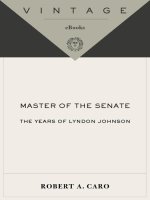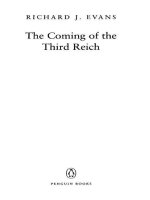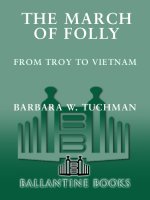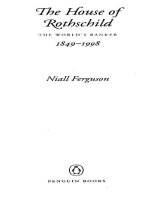Niall ferguson the house of rothschild the w 999 (v5 0)
Bạn đang xem bản rút gọn của tài liệu. Xem và tải ngay bản đầy đủ của tài liệu tại đây (6.53 MB, 574 trang )
Table of Contents
PENGUIN BOOKS
Title Page
Copyright Page
Dedication
Acknowledgements
PREFACE
I - Uncles and Nephews
ONE - Charlotte’s Dream (1849-1858)
TWO - The Era of Mobility (1849-1858)
THREE - Nationalism and the Multinational (1859-1863)
FOUR - Blood and Silver (1863-1867)
FIVE - Bonds and Iron (1867-1870)
II - Cousins
SIX - Reich, Republic, Rentes (1870-1873)
SEVEN - “The Caucasian Royal Family”
EIGHT - Jewish Questions
NINE - “On the Side of Imperialism” (1874-1885)
TEN - Party Politics
ELEVEN - The Risks and Returns of Empire (1885-1902)
TWELVE - Finances and Alliances (1885-1906)
THIRTEEN - The Military-Financial Complex (1906-1914)
III - Descendants
FOURTEEN - Deluges (1915-1945)
EPILOGUE
APPENDIX 1 - Exchange Rates
APPENDIX 2 - Selected Financial Statistics
NOTES
INDEX
PENGUIN BOOKS
HOUSE OF ROTHSCHILD
Born in Glasgow in 1964, Niall Ferguson is Fellow and Tutor of Modern History at Jesus College,
Oxford, as well as a political commentator and author. His previous publications include The House
of Rothschild: Money’s Prophets, 1798-1848, now a Penguin paperback, The Pity of War, and the
bestselling book Virtual History: Alternatives and Counterfactuals.
PENGUIN BOOKS
Published by the Penguin Group
Penguin Group (USA) Inc., 375 Hudson Street, New York, New York 10014, U.S.A.
Penguin Group (Canada), 10 Alcorn Avenue, Toronto,
Ontario, Canada M4V 3B2 (a division of Pearson Penguin Canada Inc.)
Penguin Books Ltd, 80 Strand, London WC2R 0RL, England
Penguin Ireland, 25 St Stephen’s Green, Dublin 2, Ireland (a division of Penguin Books Ltd)
Penguin Group (Australia), 250 Camberwell Road, Camberwell,
Victoria 3124, Australia (a division of Pearson Australia Group Pty Ltd)
Penguin Books India Pvt Ltd, 11 Community Centre,
Panchsheel Park, New Delhi - 110 017, India
Penguin Group (NZ), cnr Airborne and Rosedale Roads,
Albany, Auckland, New Zealand (a division of Pearson New Zealand Ltd)
Penguin Books (South Africa) (Pty) Ltd, 24 Sturdee Avenue,
Rosebank, Johannesburg 2196, South Africa
Penguin Books Ltd, Registered Offices:
80 Strand, London WC2R 0RL, England
First published in the United States of America by Viking Penguin,
a member of Penguin Putnam Inc. 1999
Published in Penguin Books 2000
10
Copyright © Niall Ferguson, 1998
All rights reserved
This is the second of two volumes of The House of Rothschild. In Great Britain
The House of Rothschild was published as one volume by Weidenfeld & Nicolson
under the title The World’s Banker: The History of the House of Rothschild.
THE LIBRARY OF CONGRESS HAS CATALOGED
eISBN : 978-1-101-15357-4
1. Rothschild family. 2. Bankers—Europe biography. 3. Business people—
Europe biography. 4. Europe—Politics and government. I. Title.
HG1552.R8F-41868
332.1’092’2—dc21
FOR LACHLAN
ILLUSTRATIONS IN THE TEXT
1.i: Anon., Der 99ste Geburtstag der Groβmutter, Fliegende Blätter (c. 1848). Source: Fuchs,
Juden in der Karikatur, p. 146.
1.ii: Anon., ONE OF THE BENEFITS OF THE JEWISH EMANCIPATION. Source: Fuchs, Juden in
der Karikatur, p. 55.
2.i: The weekly closing price of French 3 per cent and 5 per cent rentes, 1835-1857. Source:
Spectator.
3.i: The profits of the Naples house, 1849-1862 (ducats). Sources: AN, 132 AQ 13 and 14; Gille,
Maison Rothschild, vol. II, pp. 573f.
3.ii: Profits as a percentage of capital at N. M. Rothschild & Sons, Barings and Schröders, 18501880. Sources: RAL, RFamFD/13F; Ziegler, Sixth great power, pp. 373-8; Roberts, pp. 527-35.
3.iii: Das goldene Kalb (1862). Source: Cowles, Rothschilds, p. 136.
3.iv: Ferrières: Auf der groβen Jagd bei’m Rothschild (1862). Source: Wilson, Rothschild, 19th
plate.
4.i: The Prussian-Austrian yield gap (Austrian minus Prussian bond yields), 1851-1875. Source:
Heyn, “Private banking and industrialisation,” pp. 358-72.
4.ii: M. E. Schleich, Rothschild’s Kriegsbereitschaft, Ein humoristisches Originalblatt, Münchener
Punsch, 19. Nr. 20 (May 20, 1866). Source: Herding, “Rothschilds in der Karikatur,” illustration 16.
(Marburg Universitätsbibliothek.)
5.i: Baron Lionel de Rothschild (The Modern Croesus), The Period (July 5, 1870). Source: Rubens,
“Rothschilds in caricature,” plate XVII.
6.i: The weekly closing price of French 3 per cent rentes, 1860-1877. Source: Economist.
7.i: Max Beerbohm, A quiet evening in Seymour Place. Doctors consulting whether Mr Alfred may,
or may not, take a second praline before bedtime. Source: Cowles, Rothschilds, p. 172.
8.i: C. Léandre, Dieu protège Israel, Le Rêve (April 1898). Source: Herding, “Rothschilds in der
Karikatur,” p. 55, illustration 28. (Stadt- und Universitätsbibliothek, Frankfurt am Main.)
8.ii: Lepneveu, Nathan Mayer ou l‘origine des milliards, cover of Musée des Horreurs, no. 42 (c.
1900). Source: Herding, “Rothschilds in der Karikatur,” illustration 30. (Museum fur Kunst und
Gewerbe, Hamburg.)
8.iii: “Coin” Harvey, The English Octopus: It Feeds on Nothing but Gold! (1894). Source: Harvey,
Coin’s financial school, p. 215.
8.iv: Max Beerbohm, A quiet morning in the Tate Gallery ( 1907). Source: Rubens, “Rothschilds in
caricature,” plate XXI.
8.v: Christian Schöller, Die Kinder Israels ziehen ins Gelobte Land, um eine Republik zu gründen
(1848). Source: Herding, “Rothschilds in der Karikatur,” illustration 26. (Historisches Museum der
Stadt Wien).
8.vi: Anon., Auszug der Juden aus Deutschland!, Politischer Bilderbogen, Nr. 17 (1895). Source:
Herding, “Rothschilds in der Karikatur,” illustration 27. (Sammlung Germania Judaica, Cologne.)
9.i: Combined Rothschild capital, selected years (£ thousand). Source: see appendix 2, table c.
9.ii: Average annual Rothschild profits (combined houses), selected periods (£ thousand). Source:
see appendix 2, table c.
12.i: The weekly closing price of Russian 5 per cents, 1860-1900. Source: Economist.
13.i: Potted Peers: Lord Rothschild, “The whole of the British capital having been exported to the
South Pole as a result of the Budget Revolution, Lord Rothschild flies from St Swithin’s Lane and
succeeds in escaping to the Antarctic regions disguised as a Penguin,” Westminster Gazette (1909).
Source: Rothschild, Dear Lord Rothschild, illustration 21.
TABLES
ACKNOWLEDGEMENTS
A full list of acknowledgements appeared in the first volume of The House of Rothschild. I would
nevertheless like to take this opportunity to thank Barbara Grossman, Molly Stern and everyone else
at Penguin Putnam for their work in preparing both halves of the American edition.
PREFACE
If we consider the period between 1789 and 1848 as the “age of revolution,” then the Rothschilds
were surely its supreme beneficiaries. To be sure, the political upheavals of 1848-49 had cost them
dear. As in 1830, though on a far larger scale, revolutions caused the bonds of the
governments,affected to plummet in value. For the Rothschilds, who held a large proportion of their
immense wealth in the form of bonds, that meant heavy losses of capital. Worse, it brought their
“houses” in Vienna and Paris to the brink of insolvency, obliging the others—in London, Frankfurt
and Naples—to bail them out. Yet the Rothschilds survived even this, the greatest of all the financial
crises between 1815 and 1914, as well as the greatest revolution. Indeed, it would have been a
strange irony if they had not: without revolution, they would have had little to lose in the first place.
For it had been the original French Revolution that, in 1796, had literally demolished the walls of
the Frankfurt ghetto and enabled the Rothschilds to begin their phenomenal, unprecedented and since
unmatched economic ascent. Before 1789, Mayer Amschel Rothschild and his family’s lives had been
circumscribed by discriminatory legislation. Jews were prohibited from farming, or from dealing in
weapons, spices, wine and grain. They were forbidden to live outside the ghetto and were confined
there at night, on Sundays and during Christian festivals. They were subject to discriminatory
taxation. No matter how hard Mayer Amschel worked, first as a rare coin dealer then as a bill broker
and merchant banker, there were strict and low limits to what he could achieve. All that changed
when the French exported their revolution to south Germany. Not only was the Judengasse opened; the
legal restrictions on the Frankfurt Jews were also largely removed—thanks not least to Mayer
Amschel’s financial influence over Napoleon’s henchman in the Rhineland, Karl von Dalberg.
Despite the best efforts of the Frankfurt Gentiles after the French and their collaborators had been
ousted, the old apartheidlike system of residential and social restriction could never wholly be
restored.
Moreover, the Rothschilds were presented with undreamed-of business opportunities by the
revolutionary wars. As the scale and cost of the conflict between France and the rest of Europe rose,
so too did the borrowing needs of the combatant states. At the same time, the disruption of established
patterns of trade and banking created room for ambitious risk takers. Thus it was Napoleon’s decision
to drive the Elector of Hesse-Kassel into exile, which allowed Mayer Amschel (one of the Elector‘s
“court agents” since 1769) to become his principal fund manager, collecting the interest on those
assets that eluded the French and reinvesting the money. This was dangerous business: the French
police were suspicious enough about Mayer Amschel’s activities to interrogate him and his family,
though no prosecution resulted. But the profits were in proportion to the hazard; and the Rothschilds
quickly mastered the art of secrecy.
Likewise, revolution and war made possible the ascent of Mayer Amschel’s domineering son
Nathan from exporting British textiles in Manchester to financing the British war effort in the City of
London. In normal times, Nathan would doubtless have prospered as a cloth merchant: his strategy of
cutting prices and increasing volumes was right; his energy, ambition and capacity for work were all
prodigious. (“I do not read books,” he told his brothers in 1816. “I do not play cards, I do not go to
the theatre, my only pleasure is my business.”) But Britain’s wars with France created conditions
especially favorable to the bold and innovative newcomer. By prohibiting British exports to the
Continent in 1806, Napoleon inflated the risks but also the potential returns for those, like Nathan,
willing to beat the blockade. The naive will ingess of the French authorities to allow British bullion
to cross the Channel gave Nathan a still more lucrative line of business. In 1808 he was able to leave
Manchester for London, now unrivaled as the world’s biggest financial center since the Napoleonic
occupation of Amsterdam.
The “masterstroke” which enabled Nathan to leap into the first league of merchant bankers was his
use of the Elector of Hesse-Kassel’s English investments to bolster his own resources. In 1809
Nathan secured authorization to make new purchases of British bonds with the interest the Elector’s
existing portfolio was earning; over the next four years he bought securities worth more than
£600,000. In peace-time this would have made him a major fund manager; in the turmoil of war,
however, Nathan was able to treat the Elector’s bonds like his own capital. Unwittingly, the exiled
Elector became a sleeping partner in a new banking house: N. M. Rothschild. (His minister Buderus
was a more willing investor in the Frankfurt house.) In 1813 Nathan was therefore able credibly to
offer his services to the British government as it struggled to finance Wellington’s penultimate
campaign against Napoleon. This was what Carl meant when he said later that “the Old Man”—
meaning William—had “made our fortune.”
In truth, they probably owed more to the industry and acumen of their own “old man.” It was Mayer
Amschel who in 1810 designed the partnership structure that was to endure, modified but essentially
the same, for very nearly a century, binding together the male line over four generations, rigorously
excluding female Rothschilds and their spouses. And it was Mayer Amschel who taught his sons such
hard-nosed business rules as: “It is better to deal with a government in difficulties than with one that
has luck on its side”; “If you can’t make yourself loved, make yourself feared”; and “If a high-placed
person enters into a [financial] partnership with a Jew, he belongs to the Jew” (“gehört er dem
Juden”). This last piece of advice lay behind the brothers’ practice of plying politically powerful
individuals with gifts, loans, investment tips and outright bribes. Above all, Mayer Amschel taught
his sons to value unity: “Amschel,” he told his eldest son on his deathbed in 1812, “keep your
brothers together and you will become the richest people in Germany.” His sons were still repeating
these precepts to the next generation thirty years later, by which time they were the richest people in
the world; indeed, the richest family in all history.
The operations of 1814 and 1815, in which Nathan and his brothers raised immense quantities of
bullion not only for Wellington but also for Britain’s continental allies, ushered in a new era in
financial as well as political history. The Rothschilds stretched their credit to breaking point,
sometimes losing sight altogether of their assets and liabilities, gambling everything they owned for
the sake of governmental commissions, interest payments and speculative gains from exchange rate
and bond yield fluctuations. In 1815 alone, Nathan’s account with the British government totalled
close to £10 million, a huge sum at that time. Lord Liverpool employed heroic English understatement
when he called Nathan “a very useful friend.” It was, as other contemporaries acknowledged,
Napoleonic finance, without which Napoleonic generalship could not have been defeated. Ludwig
Borne justly called the brothers “Finanzbonaparten”; Nathan, as Salomon acknowledged, was their
“commanding general.” Though they came perilously close to ruin when the French were defeated at
Waterloo—a much quicker end to the war than Nathan had foreseen—the Rothschilds emerged in
1815 as sterling millionaires. Almost at once, Nathan embarked on perhaps the most successful
transaction of his career: a huge investment in British government bonds (consols) whereby he rode
the upswing caused by the government’s postwar financial stabilization, taking his profits just before
the market peaked. This was Nathan’s supreme Meistergeschäft, realizing profits of more than
£250,000 at a stroke.
The 1820s were a time of political as well as fiscal restoration. Throughout the Continent, the
deposed were (mostly) put back on their thrones. Under the leadership of Prince Metternich, the great
continental powers combined to resist new revolutionary impulses wherever they might occur. The
Rothschilds bankrolled this restoration, no doubt. They enabled Austria, Prussia and Russia—the
members of the Holy Alliance—as well as the restored Bourbons in France, to issue bonds at rates of
interest only Britain and Holland had previously been able to enjoy. In that this made it easier for
Prince Metternich to “police” Europe—notably when Austria and France intervened to restore the
Bourbon regimes in Naples and Spain—there was truth in the jibe that the Rothschilds were the
“chief ally of the Holy Alliance.” Rothschild loans also bolstered the private finances of many of the
“high-placed persons” of the period, including Metternich himself, King George IV and his son-inlaw Leopold of Saxe-Coburg, later King of the Belgians. As Ludwig Borne complained, “Rothschild”
was “someone who gives nobles the power to spite freedom and deprives peoples of the courage to
resist violence ... the high priest of fear ... on whose altar liberty, patriotism, honour and all civil
virtues are sacrificed.”
Yet there was always an ambivalence about the Rothschilds’ view of the restoration. They could
hardly relish the return to power of conservative elites which—most obviously in Germany—sought
to reimpose second-class citizenship on the Jews. Nor was Nathan the kind of man to turn down good
business on ideological grounds. Interventions by the Holy Alliance against revolutionary movements
in Spain or Italy were not necessarily good for business: war unsettled the bond markets, not least
because of its deleterious effect on state budgets. The new regimes that emerged in countries like
Spain, Brazil and Greece were also potential new customers ; and experience seemed to suggest that
parliamentary monarchies were better creditors than absolutist regimes. Significantly, the Rothschilds
were tempted to lend to the Spanish liberals, but refused to bankroll Ferdinand VII after he had been
restored to absolute power. As Byron put it in Don Juan, the Rothschilds held sway over “royalist
and liberal” alike. Heinrich Heine went further in calling Rothschild a revolutionary on a par with
Robespierre, because
Rothschild ... destroyed the predominance of land, by raising the system of state bonds to
supreme power, thereby mobilising property and income and at the same time endowing
money with the previous privileges of the land.
It was also Heine who memorably declared: “[M]oney is the god of our time and Rothschild is his
prophet.” Without doubt, the Rothschilds’ most important contribution to economic history was the
creation of a truly international bond market. There had, of course, been cross-border capital flows
before: the Dutch had invested in British government bonds in the eighteenth century while the
Rothschilds’ rivals in Frankfurt, the Bethmanns, had marketed large issues of Austrian bonds in the
same period. But never before had a country’s bonds been simultaneously issued in multiple markets
with (as in the case of Prussia in 1818) such alluring conditions as denomination in sterling, payment
of interest at the place of issue and a sinking fund.
Bond issuance was not the Rothschilds’ sole business. They also discounted commercial bills,
acted as bullion brokers, dealt in foreign exchange, engaged directly in commodity trade, dabbled in
insurance and even offered private banking services to an elite of indivual clients. Their role in the
gold and silver markets was important: it was the Rothschilds’ role as “lender of last resort to the
lender of last resort” that prevented a suspension of convertibility by the Bank of England in 1825.
But it was the bond market which came first. Moreover, buying and selling in the various secondary
markets for bonds was almost as important a source of profit as issuance: this was the principal form
of speculation in which the brothers engaged.
It was partly the multinational character of their operations that distinguished the Rothschilds from
their competitors. While Nathan’s eldest brother Amschel continued the original family business in
Frankfurt, his youngest brother James established himself in Paris. Later in the 1820s. Salomon and
Carl established subsidiaries of the Frankfurt house in Vienna and Naples. The five houses formed a
unique partnership, acting jointly in big transactions, pooling profits and sharing costs. Regular and
detailed correspondence overcame the obstacle of geographical separation. The partners met together
only every few years, when changing circumstances necessitated modification of their contractual
agreement.
This multinational structure gave the Rothschilds several important advantages. First, it enabled
them to engage in arbitrage, exploiting price differences between, say, the London and Paris markets.
Secondly, they could bail one another out in the event of liquidity or solvency squeezes. Never—not
even in 1848—did financial crises strike everywhere in Europe simultaneously and with equal
severity. When Britain suffered in 1825, James could bail out Nathan. When Paris collapsed in 1830,
Nathan could reciprocate. There is no doubt that the Vienna house would have gone bankrupt in 1848
if it had been an independent entity. Only the willingness of the other houses to write off substantial
sums allowed Salomon’s son Anselm to restore it.
By rapidly accumulating capital—the Rothschilds did not distribute profits, contenting themselves
with a low interest on their individual partnership shares—they were soon able to conduct such
operations on an unparalleled scale. They were certainly the biggest bank in the world; by 1825 ten
times the size of their nearest rivals, Baring Brothers. This in turn allowed them to modify their
business strategy. After the early years of high risk and high returns, they were now able to content
themselves with lower profitability without compromising their position of market dominance.
Indeed, this shift away from profit maximization helps to explain the Rothschild partnership’s
longevity as a firm. Time and again they would encounter competitors—Jacques Laffitte was the
classic example of the restoration period—who gained on them during market upswings by taking
bigger risks, only to come unstuck when the cycle dipped.
With riches came status. In the eyes of contemporaries, the Rothschilds personified new money:
they were Jews, they were ill educated, they were coarse—yet within a few years they had
accumulated net paper wealth worth far more than most aristocratic estates. Outwardly, the arrivistes
seemed to crave acceptance by the old elites. As if to expunge the memory of the days when (as Carl
recalled) “we all slept in one little attic room,” they bought the smartest of town houses in streets like
Piccadilly and the rue Laffitte and, later, their first country houses at Gunnersbury, Ferrieres and
Schillersdorf. They filled them with seventeenth-century Dutch paintings and eighteenth-century
French furniture. They hosted lavish dinners and glittering balls. They sought titles and other honors:
plain Jacob Rothschild became Monsieur le Baron James de Rothschild, Austrian consul general in
Paris, chevalier of the Legion of Honour. They brought up their sons as gentlemen, giving them tastes
for pleasures that had been unknown in the ghetto: horses, hunting and fine art. Their daughters had
their piano lessons from Chopin. Men of letters—notably Disraeli, Heine, Balzac—sought patronage
from these new Medicis, only to caricature them in their work.
Yet the Rothschilds privately viewed their own social ascent with cynicism. Titles and honors
were “part of the racket,” helpful in giving the brothers access to the corridors of power. Playing host
was an uncomfortable duty, to the same end: much of it was corporate hospitality, as we would now
say. Even the gentrification of the next generation was superficial: their sons’ real education was still
in the “counting house.”
The Rothschilds’ most important reservation about social assimilation was religious. Unlike many
other wealthy European Jews, who opted to convert to Christianity in the 1820s, the Rothschilds
remained firmly attached to the religion of their forefathers. Though the extent of their individual
religiosity varied—while Amschel was strict in his observance, James was very lax—the brothers
shared the view that their worldly success was intimately bound up with their Judaism. As James put
it, religion meant “everything. Our good fortune and our blessings depend upon it.” When Nathan’s
daughter Hannah Mayer converted to Christianity in order to marry Henry Fitzroy in 1839, she was
ostracized by nearly all her relatives, including her own mother.
The corollary of the Rothschilds’ belief that fidelity to Judaism was integral to their worldly
success was the interest they took in the fate of their “poorer co religionists.” This commitment to the
wider Jewish community extended beyond traditional charitable donations to embrace systematic
political lobbying for Jewish emancipation. The practice that Mayer Amschel had established in the
Napoleonic period, of using Rothschild money to secure or defend the civil and political rights of
Jews, continued more or less uninterruptedly throughout the century. When the Jews of Damascus
were falsely accused of “ritual murder” in 1840, the Rothschilds orchestrated a successful campaign
to end their persecution. This was only the most celebrated of many cases. Rothschild loans to the
pope were also used as a lever to improve the lot of the Jews in the papal states. Ironically, the
English Rothschilds’ efforts closer to home were less successful. Nathan and his wife Hannah had
first become involved in the campaign to end Jewish exclusion from Parliament as early as 1829. By
the time of Nathan’s death seven years later, nothing had been achieved. It was left to his son Lionel
to lead the campaign for Anglo-Jewish emancipation: the subject of this volume’s opening chapter.
Nevertheless, the Rothschilds’ sense of identification with the wider Jewish community was not
unqualified. Not only their wealth but their genealogy set them apart from the rest of European Jewry.
For the Rothschilds pursued a strategy of endogamy-marrying not just within their own faith but
within their own immediate kinship group. Only a Rothschild would do for a Rothschild, it seemed:
of twenty-one marriages involving descendants of Mayer Amschel between 1824 and 1877, no fewer
than fifteen were between his direct descendants. Typical was the marriage of Nathan’s son Lionel to
Carl’s daughter Charlotte in 1836, an arranged and not very happy match. The main rationale behind
this strategy was to fortify the cohesion of the financial partnership. It certainly did this, though to
modern eyes the family tree of the period looks fraught with genetic risk. Cousin marriages ensured
that the family’s capital was not dispersed. Like the strict rule that excluded daughters and sons-inlaw from the partnership’s hallowed books, and the repetition of Mayer Amschel’s imprecations to
maintain fraternal unity, it was one of the devices that prevented the Rothschilds from going the way
of Thomas Mann’s decadent Buddenbrooks. Of course, other dynasties behaved in similar ways.
Cousin marriage was relatively common in Jewish business families. Nor was it confined to Jews:
British Quakers practiced it too. Indeed, even Europe’s royal families used cousin marriage to cement
their political relationships. Yet the Rothschilds practiced endogamy to a degree not even the SaxeCoburgs could match. It was this that prompted Heinrich Heine to call them “the exceptional family.”
Indeed, other Jews came to regard the Rothschilds as a kind of Hebrew royal family: the “Kings of
the Jews” as well as the “Jews of the Kings.”
The revolution of 1830 revealed two important things. First, the Rothschilds were not tied to the
Holy Alliance but were perfectly willing to offer their financial services to liberal and even
revolutionary regimes. If anything—once he had got over the initially severe shock of the revolution
—James found it easier to do business with the “bourgeois monarchy” of Louis Philippe. Equally
congenial was the new Belgian state, especially when it (like Greece) accepted a “tame” German
prince as its monarch—one who was already a Rothschild client—and subordinated itself to
collective international regulation by the great powers. The second point was that the Rothschilds had
a strong interest in seeing the great powers reach such arrangements and believed that here too
financial leverage could be exerted.
The outbreak of revolution had caused a major slump in the price of French rentes (the perpetual
bonds that were to France what consols were to Britain). The slump had taken James almost wholly
by surprise, plunging his balance sheet into the red. But what made the European financial markets so
volatile in the early 1830s—and delayed the recovery of the rente even after a more or less stable
parliamentary monarchy had been established—was the fear that, as in the 1790s, a French revolution
would engender a European war. It was this fear as much as anything else which caused the financial
contagion of the period, pushing up bond yields even in countries unaffected by revolution.
At various times in the early 1830s war threatened to break out over Belgium, Poland or Italy. The
Rothschilds were now well enough connected to act as peace brokers on each occasion. Their
uniquely fast communications network—which relied principally on private couriers to-ing and froing with copies of letters—was by now also being used by the leading statesmen of the continent as
an express postal service. This gave the family one form of power: knowledge. James saw Louis
Philippe, heard his views, wrote them down in his letter to Salomon, who went to see Metternich, and
passed them on. The process then repeated itself in reverse, with Metternich’s reply reaching Louis
Philippe via at least two Rothschilds. Needless to say, the messengers could subtly alter the messages
along the way; or the news could be acted upon in the stock exchanges before being passed on.
At the same time, the Rothschilds’ dominance of the international bond market gave them a second
form of power. Because any state that seriously contemplated going to war would have to borrow
money to do so, the Rothschilds discerned the possibility that they could exercise a veto: no peace, no
cash. Or as the Austrian diplomat Count Prokesch von Osten said in December 1830: “It is all a
question of ways and means and what Rothschild says is decisive, and he won’t give any money for
war.”
It did not quite work so neatly. Though contemporaries were enchanted by the idea that the
Rothschilds could keep the European peace merely by threatening to ration credit, in reality there
were other reasons why war did not break out in the 1830s. Still, at certain times the Rothschilds
were able to wield political power by financial means. Metternich’s bellicosity was, if not thwarted,
at least dampened by Salomon’s explicit refusal to support a new loan in 1832. And the creation of
Greece and Belgium as new states was literally underwritten by Rothschild finance in the form of
loans guaranteed by the great powers and floated by the Rothschilds.









